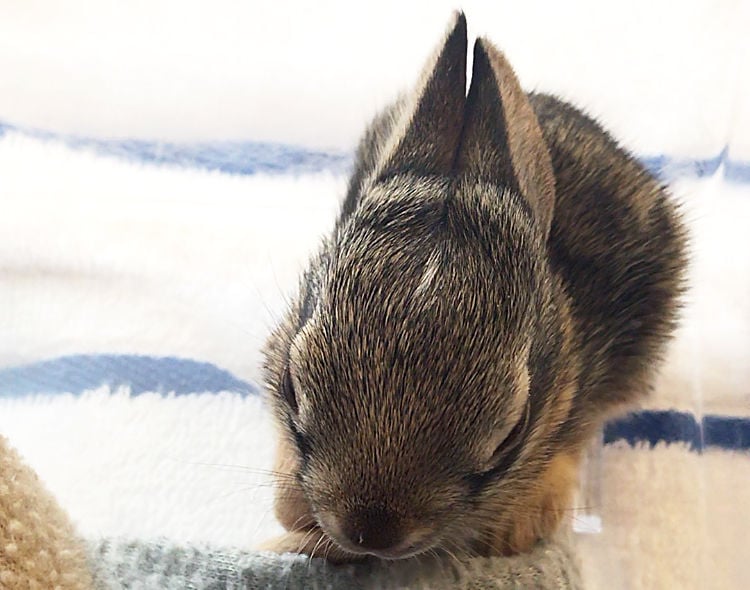Dressed in camouflage, Lou Rae Whitehead feeds a baby screech owl mice using a fluffy owl puppet.Â

Lou Rae Whitehead feeds a baby screech owl while wearing a ghillie suit and an owl puppet so it does not get used to being fed by humans.Â
The puppet and ghillie suit are ways to ensure the baby owl does not get used to humans so the ÃÛèÖÖ±²¥ Wildlife Center can release it back to the desert after it is rehabilitated, Whitehead, the center's animal care supervisor said.Â
This is a typical scene at the center, especially during spring and summer months, when hundreds of baby animals are brought there to be rehabilitated and released.Â

Bobcat kittens are often mistaken for domestic kittens by people who find them.Â
There are currently 239 animals on site — from baby birds to bobcat kittens. Last year, the center cared for 3,430 desert critters. The count for this year is already up to 926.Â
Many of the animals are hurt by cats or dogs or fall out of their nests, Whitehead said.Â
You can help in their rescue. But, there are proper ways to do it and things to look out for.Â

A baby javelina plays with a stuffed animal at the ÃÛèÖÖ±²¥ Wildlife Center.Â
First of all, do not touch baby mammals, with the exception of bunnies or squirrels, Whitehead said.Â
"If a bobcat, coyote, javelina, or raccoon bites you, it's a death sentence because we have to have them tested," Whitehead said. "State law requires us to test them for rabies."Â
Is it a bobcat or domestic kitten?

Baby bobcats have eye-like markings on the back of their ears.Â
People don't always realize they have found a bobcat because they look a lot like regular kittens, Whitehead said.Â
To tell the difference, there are two things to check.
Bobcat kittens have markings on the back of their ears that look like eyes.Â
And they have little tails.Â
If you think you have a bobcat kitten, don't touch it without protective gear. Call the ÃÛèÖÖ±²¥ Wildlife Center.Â

One of two bobcat kittens at the ÃÛèÖÖ±²¥ Wildlife Center.
I found a baby mammal. What do I do?Â
As mentioned above, try not to touch the animal without gloves.
Prepare a box or pet carrier by putting a soft cloth on the bottom. If it's a box, put air holes in it. Cover the animal with a light sheet or towel, gently pick it up and place it in the prepared container. Tape the box shut.Â

Coyote puppies are often mistaken for domestic puppies. It's not uncommon for the ÃÛèÖÖ±²¥ Wildlife Center to receive calls from Pima Animal Care Center because somebody has brought them a coyote puppy.Â
Note exactly where you found the animal, so it can be released there.Â
Keep the animal in a quiet, warm place. Don't bother, handle or give it food or water. Contact the ÃÛèÖÖ±²¥ Wildlife Center as soon as possible to have it picked up or to arrange drop off. Wash your hands.Â
What about baby birds?
If you see a baby bird on the ground, it's okay to put it back in its nest, Whitehead said. In fact, if you see the nest and can get to it, you should try to put the bird in it.Â
The mother bird will still care for it even if a human touches it.Â
"Moms just want their babies back," Whitehead said.Â

A baby hawk that fell from a tree and suffered some neurological damage is being rehabilitated at the ÃÛèÖÖ±²¥ Wildlife Center. When it is well enough, it'll be released into the wild.Â
Only adults should rescue baby birds, though. If it's an adult bird that needs help, seek guidance from ÃÛèÖÖ±²¥ Wildlife Center first.Â
If you can't get to the nest here's what to do:
Put something soft on the bottom of a box, preferably paper towels, so the bird doesn't slip and slide.Â
"We prefer paper towels because some birds have a fork tongue and they can get it caught in the loops of the cloth," Whitehead said.Â
Put on some gloves if you have them. Cover the bird with a light sheet or towel, then gently pick it up and put it in the box. Make sure to poke holes in the top so it can breathe.Â

A baby screech owl was found between somebody's door and screen door and turned in to the ÃÛèÖÖ±²¥ Wildlife Center, where it is being cared. The center suspects the owl jumped out of its nest in an attempt to fly and got stuck.Â
If you have to keep it over night, you can put a small lid with a little bit of water in it.
Make sure to take note of where you found the bird so it can be released close to home.Â
Get it to ÃÛèÖÖ±²¥ Wildlife Center as fast as soon as you can.Â
If you're unsure of what to do, the ÃÛèÖÖ±²¥ Wildlife Center asks that you call them at 290-9453 for advice.Â
The center is in need of summer volunteers for bird and baby animal care. Click to learn more and to apply.Â










